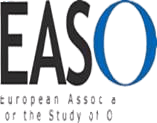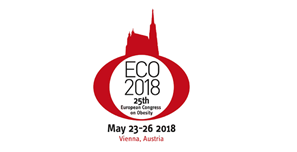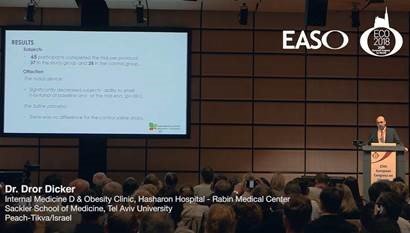THE SCIENCE BEHIND
NOZNOZ™
OUR SMALL PROOF OF CONCEPT CLINICAL TRIAL
We had conducted a small proof of concept clinical trial, with 65 participants completing the trial, to examine NozNoz. The pilot trial was conducted in two leading medical centers in Israel, and was approved by the ethical committees of the medical centers and by the Israeli ministry of health.
This pilot trial was funded by Beck Medical.
THE PI WAS DR. DROR DICKER
Head of the Obesity Clinic at Hasharon Hospital-Rabin Medical Center in Petah Tikva, president of the Israeli Association for the Study of Obesity and co-chair of the Obesity Management Task Force of the European Association for the Study of Obesity. READ MORE >
BACKGROUND
The role of olfaction in regulating appetite, food intake, and body weight has been studied extensively, but is so complex that we have only begun to understand this system. Exposure to food odors increases food intake and loss of smell reduces food intake. Overweight and obese humans and animals tend to have a reduced sense of smell compared to lean individuals, however, obese individuals exposed to pleasant smelling food odors eat more of a test meal than do lean individuals (2,3) and restrained eaters eat more when exposed to food odors (4,5). READ MORE >


METHODS

NOZNOZ™
subjects in the NozNoz arm wore the product for 5-12 hours a day.


CONTROL
- Received a balanced dietary consolation for reduction of about 500 kcal/day from their regular diet.
- Follow-up visits at the clinic occurred once in two weeks.
- Self-Management of a food and usage diary
- Blood tests and smelling capacity test conducted at beginning and end of the study
RESULTS
Sixty five subjects completed the study per protocol: 37 in the NozNoz group 28 in control;
NozNoz reduced the sense of smell significantly (p<.001) when in the nose, while saline drops did not change olfaction.

WEIGHT LOSS

Significantly more participants in the NozNoz group relatively to control (for the whole group) reported they reduced consumption of sugar, artificial sweeteners and sweet beverages.



SUMMARY
In our small pilot clinical trial, NozNoz demonstrated the following as compared to the control:
- Reducing sugar, artificial sweeteners and sweet beverages consumption
- Reducing body weight – for age 50 years or younger
- Reducing smelling capacity
Additional studies should be conducted to further explore this new option and to determine the role of NozNoz for treatment.
THE MEDICAL CENTERS
Hasharon Hospital at Rabin Medical Center in Petach Tikva
and Emek Medical Center in Afula
Both are part of Clalit Health Services – the largest healthcare provider in Israel.



Publications in the media
BACKGROUND
The role of olfaction in regulating appetite, food intake, and body weight has been studied extensively, but is so complex that we have only begun to understand this system. Exposure to food odors increases food intake and loss of smell reduces food intake. Overweight and obese humans and animals tend to have a reduced sense of smell compared to lean individuals, however, obese individuals exposed to pleasant smelling food odors eat more of a test meal than do lean individuals (2,3) and restrained eaters eat more when exposed to food odors (4,5). Both lean and overweight individuals had an increased hunger rating after seeing and smelling pizza for 60 seconds, but overweight individuals had increased salivation and an increased desire to eat both pizza and other tasty foods as compared to lean (6).
There are few data on the effects of reduced smell on food intake and weight, and almost all studies have been in animals. Riera (1) knocked out olfactory neurons mice, resulting in decreased smell. They noted a slight decrease in food intake on regular healthy chow, but a larger decrease on high fat diet. They found a significant reduction in body weight and fat mass with no change in lean mass and a significant increase in energy expenditure (1).
Of particular note, in humans- olfaction declines starting about age 50. No studies have deliberately reduced smell and assessed weight loss and food preferences in human beings.
Publications of NozNoz Study
- Published on the scientific magazine OBESITY FACTS , click here
- Presented at scientific conferences, including the 2 most prestige conferences in the era of Obesity:
- Europe: ECO 2018 (European Conference of Obesity) and the EASO European Association for the Study of Obesity.
- USA: OBESITY WEEK 2019



SCIENTIFIC REFERENCES
- Riera CE, Tsaousidou E, Halloran J, Follett P, Hahn O, Pereira MMA, et al. The Sense of Smell Impacts Metabolic Health and Obesity. Cell Metab. 2017 Jul 5;26(1):198-211.e5. doi: 10.1016/j.cmet.2017.06.015. PubMed PMID: 28683287
https://www.ncbi.nlm.nih.gov/pubmed/28683287 - Jansen A, Theunissen N, Slechten K, Nederkoorn C, Boon B, Mulkens S, et al. Overweight children overeat after exposure to food cues. Eat Behav. 2003 Aug;4(2):197-209. PubMed PMID: 15000982. https://www.ncbi.nlm.nih.gov/pubmed/15000982
- Stafford LD, Whittle A. Obese individuals have higher preference and sensitivity to odor of chocolate. Chem Senses. 2015 May;40(4):279-84. doi: 10.1093/chemse/bjv007. Epub 2015 Mar 13. PubMed PMID: 25771359.
http://citeseerx.ist.psu.edu/viewdoc/download?doi=10.1.1.1029.3882&rep=rep1&type=pdf - Rogers PJ, Hill AJ. Breakdown of dietary restraint following mere exposure to food stimuli: interrelationships between restraint, hunger, salivation, and food intake. Addict Behav. 1989;14(4):387-97. PubMed PMID: 2782122.
https://www.ncbi.nlm.nih.gov/pubmed/2782122 - Fedoroff I, Polivy J, Herman CP. The specificity of restrained versus unrestrained eaters’ responses to food cues: general desire to eat, or craving for the cued food? Appetite. 2003 Aug;41(1):7-13. PubMed PMID: 12880616.
https://www.ncbi.nlm.nih.gov/pubmed/12880616 - Ferriday D, Brunstrom JM. ‘I just can’t help myself’: effects of food-cue exposure in overweight and lean individuals. Int J Obes (Lond). 2011 Jan;35(1):142-9. doi: 10.1038/ijo.2010.117. Epub 2010 Jun 15. PubMed PMID: 20548302.
https://www.ncbi.nlm.nih.gov/pubmed/20548302 - Palouzier-Paulignan B, Lacroix MC, Aimé P, Baly C, Caillol M, Congar P, et al. Olfaction under metabolic influences. Chem Senses. 2012 Nov;37(9):769-97. doi: 10.1093/chemse/bjs059. Epub 2012 Jul 25. PubMed PMID: 22832483; PubMed Central PMCID: PMC3529618.
https://www.ncbi.nlm.nih.gov/pubmed/22832483 - Aschenbrenner K, Hummel C, Teszmer K, Krone F, Ishimaru T, Seo HS, et al. The influence of olfactory loss on dietary behaviors. Laryngoscope. 2008 Jan;118(1):135-44. PubMed PMID: 17975508.
https://www.ncbi.nlm.nih.gov/pubmed/17975508 - Steve Van Toller, Assessing the Impact of Anosmia: Review of a questionnaire findings, Chemical Senses, Volume 24, Issue 6, 1 December 1999, Pages 705–712,
https://doi.org/10.1093/chemse/24.6.705 - Ketterer C, Heni M, Thamer C, Herzberg-Schäfer SA, Häring HU, Fritsche A. Acute, short-term hyperinsulinemia increases olfactory threshold in healthy subjects. Int J Obes (Lond). 2011 Aug;35(8):1135-8. doi: 10.1038/ijo.2010.251. Epub 2010 Nov 23. PubMed PMID: 21102552.
https://www.ncbi.nlm.nih.gov/pubmed/21102552 - Tong J, Mannea E, Aimé P, Pfluger PT, Yi CX, Castaneda TR, et al. Ghrelin enhances olfactory sensitivity and exploratory sniffing in rodents and humans. J Neurosci. 2011 Apr 13;31(15):5841-6. doi: 10.1523/JNEUROSCI.5680-10.2011. PubMed PMID: 21490225; PubMed Central PMCID: PMC3089941.
https://www.ncbi.nlm.nih.gov/pmc/articles/PMC3089941/ - Lushchak OV, Carlsson MA, Nässel DR. Food odors trigger an endocrine response that affects food ingestion and metabolism. Cell Mol Life Sci. 2015 Aug;72(16):3143-55. doi: 10.1007/s00018-015-1884-4. Epub 2015 Mar 18. PubMed PMID: 25782410.
https://www.ncbi.nlm.nih.gov/pubmed/25782410 - Thanos PK, Robison LS, Robinson JK, Michaelides M, Wang GJ, Volkow ND. Obese rats with deficient leptin signaling exhibit heightened sensitivity to olfactory food cues. Synapse. 2013 Apr;67(4):171-8. doi: 10.1002/syn.21627. Epub 2012 Dec 20. PubMed PMID: 23172699; PubMed Central PMCID: PMC3578169.
https://www.ncbi.nlm.nih.gov/pmc/articles/PMC3578169/ - Doty RL, Kamath V. The influences of age on olfaction: a review. Front Psychol. 2014 Feb 7;5:20. doi: 10.3389/fpsyg.2014.00020. eCollection 2014. Review. PubMed PMID: 24570664; PubMed Central PMCID: PMC3916729.
https://www.ncbi.nlm.nih.gov/pubmed/24570664 - Duffy VB, Backstrand JR, Ferris AM. Olfactory dysfunction and related nutritional risk in free-living, elderly women. J Am Diet Assoc. 1995 Aug;95(8):879-84; quiz 885-6. PubMed PMID: 7636078.
https://www.ncbi.nlm.nih.gov/pubmed/7636078 - Schiffman S, Pasternak M. Decreased discrimination of food odors in the elderly. J Gerontol. 1979 Jan;34(1):73-9. PubMed PMID: 759495.
https://www.ncbi.nlm.nih.gov/pubmed/9343468
THE PRINCIPLE INVESTIGATOR

Dr Dror Dicker, Principle Investigator
Dr Dror Dicker president of the Israeli Association of the Study of Obesity. Head of internal Medicine D and Obesity Clinic, Hasharon Hospital–Rabin Medical Center.
Co-Chair of the Obesity Management Task Force of the European Association for the Study of Obesity (EASO). Have been elected as the next president of the European Federation of Internal Medicine (EFIM). Dr Dror Dicker is practicing medicine for over 20 years. Authored and co-authored multiple peer-reviewed scientific papers and is well recognized and known for his work in many fields such as obesity, diabetes and hypertension. Editor and writer of related articles and opinions in various medical channels and websites. Past Chairman of the Israel Association of Internal Medicine. Dr Dicker lives in Israel and is a father to 3 children.

 Researchers from Israel have developed a device called NozNoz that is inserted into your nose to reduce smelling ability, and in turn helps you lose weight.
Researchers from Israel have developed a device called NozNoz that is inserted into your nose to reduce smelling ability, and in turn helps you lose weight.











